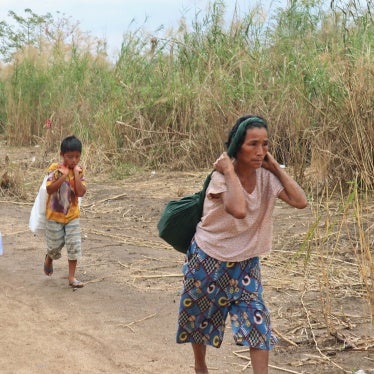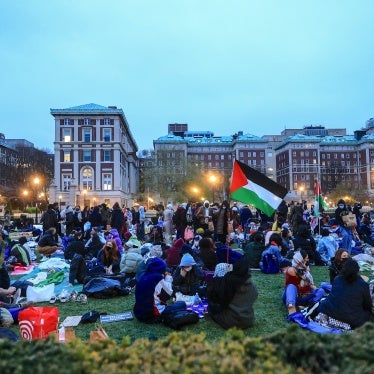We write in advance of the 98th pre-session of the Committee on the Rights of the Child (“the Committee”) and its review of Pakistan. This submission focuses on the right to free and compulsory education and the protection of education from attack.
Right to Free and Compulsory Education (articles 2, 19, 28, 32, and 34)
According to Pakistan’s constitution, education is free and compulsory for children between the ages of 5 and 16,[1] yet school dropout remains a serious challenge. Government data indicate an overall retention rate to the fifth grade in 2020-2021 of 79 percent[2]; with the highest gender disparity in Khyber Pakhtunkhwa province, with 86 and 67 percent for boys and girls, respectively. Retention rates further drop at the upper levels: overall retention to the eighth grade stood at around 60 percent, with the minimum observed at just 33 percent for girls in Azad Jammu and Kashmir, whereas the overall retention rate to the tenth grade—the end of compulsory education—stood at just 50 percent.[3]
Pakistan offers neither free nor compulsory pre-primary education. A lack of readiness for school contributes to the high dropout rates in early grades, according to Pakistan’s 2018 National Education Policy Framework.[4]
In 2018, Human Rights Watch documented several other barriers to education for girls in all four of Pakistan’s provinces.[5] Those include the government’s under-investment in schools, lack of schools, prohibitive school fees and related costs, corporal punishment, and a failure to enforce compulsory education. Further issues include the poor quality of education in both government and low-cost private schools, a lack of government regulation of private schools, and corruption. In addition to these factors within the education system, girls are blocked from attending school by external factors including child labor, gender discrimination, child marriage, sexual harassment, and attacks on students, teachers, and schools.[6] According to the World Bank, long commutes and difficult road conditions disproportionately impact girls’ access to education, especially in mountainous regions such as Khyber Pakhtunkhwa province.[7]
In a global report on the impact of Covid-19 on children’s access to education, Human Rights Watch also found that living in rural areas in Pakistan without the adequate availability of or access to electricity and broadband connections, as well as limited household resources, including lack of access to or ability to pay for internet and digital devices, created obstacles to children’s access to online learning.[8]
Human Rights Watch recommends that the Committee ask the government of Pakistan:
- What plans does the government have to remove the obstacles for girls’ participation in education?
- How is the government addressing the learning inequities that resulted from disparate access to goods necessary for remote education, including digital devices and the internet, during Covid-19 school closures?
- What barriers does the government see to expanding the right to free and compulsory education to include at least one year of pre-primary education?
Human Rights Watch encourages the Committee to call on the government of Pakistan to:
- Legislate that at least one year of pre-primary education be free and compulsory and take immediate measures to ensure primary and secondary compulsory education is available and accessible to all free of charge.
- Ensure appropriate follow-up for children who drop out of school or are absent from school for prolonged periods of time, including by offering bridging programs for out-of-school children to transition back into the educational system.
- Adopt measures to increase the number and quality of schools, including at the pre-primary level.
- Develop and implement a time-bound plan to achieve full gender parity on educational participation, from pre-primary through higher education.
- To the extent that online learning is used beyond Covid-19 school closures, develop or expand device affordability and availability initiatives for schools and families, with support targeted at the most marginalized children, and adopt measures to ensure access to affordable, reliable, quality, and accessible internet, including targeted measures to provide free, equitable access to the internet for educational content, and in a manner that protects children’s privacy online.
Protection of Education from Attack (articles 2 and 28)
In 2022, the Global Coalition to Protect Education from Attack (GCPEA) found at least seven attacks on schools in Pakistan by non-state armed groups during the reporting period 2020-2021. Armed groups targeted girls and women in several incidents. Security forces arrested at least 240 school students and personnel for participating in education-related protests.[9]
For the 2017-2019 reporting period, GCPEA compiled approximately 50 reported incidents of attacks on schools—with nearly half of these reported attacks occurring against girls’ schools— and at least 27 reported incidents of attacks on students, teachers, and other education personnel.[10] Non-state armed groups and unidentified attackers were allegedly responsible for targeted killings, abductions, and indiscriminate attacks against primary and secondary school students.
Pakistan’s 1938 Manoeuvres, Field Firing and Artillery Practice Act provides that “military forces engaged in … manoeuvres” are not authorized “entry on or interference with any ... educational institution,” and therefore may not “pass over, or encamp, construct military works of temporary character, or execute military manoeuvre” on such areas.[11]
The Safe Schools Declaration[12] is an inter-governmental political commitment that provides countries the opportunity to express political support for the protection of students, teachers, and schools during times of armed conflict; the importance of the continuation of education during armed conflict; and the implementation of the Guidelines for Protecting Schools and Universities from Military Use during Armed Conflict. [13] In June 2022, the United Nations Secretary-General encouraged all governments to endorse the Safe Schools Declaration.[14] As of January 2024, 119 states had endorsed the declaration, including 31 of Pakistan’s fellow members of the Organisation of Islamic Cooperation.[15] Pakistan has not endorsed the declaration.
As of November 2023, Pakistan provides 4021 troops to UN peacekeeping missions, ranking fifth in contributions by country.[16] Pakistan has deployed a significant number of peacekeeping troops in the Democratic Republic of the Congo, the Central African Republic, Abyei, South Sudan, and Mali—all countries and areas where attacks on schools have been documented as a problem.[17] The 2017 Child Protection Policy of the UN Department of Peace Operations, Department of Field Support, and Department of Political Affairs notes: “United Nations peace operations should refrain from all actions that impede children’s access to education, including the use of school premises. This applies particularly to uniformed personnel. Furthermore … United Nations peace operations personnel shall at no time and for no amount of time use schools for military purposes.”[18]
In 2017, this Committee recommended that Pakistan “prevent... the occupation of schools by armed groups” and urged Pakistan to “monitor non-State armed Groups and prohibit them from accessing educational facilities.”[19] The UN Committee on Economic, Social and Cultural Rights also recommended in 2017 that Pakistan “immediately and completely ban the use of schools by military forces” and invited Pakistan to endorse the Safe Schools Declaration.[20]
Human Rights Watch recommends that the Committee ask the government of Pakistan:
- What progress has been made in implementing this Committee’s 2017 recommendation that Pakistan “monitor non-State armed Groups and prohibit them from accessing educational facilities”?
- Are protections for schools from military use included in any other policies, rules, or trainings for Pakistan’s armed forces?
- Does pre-deployment training for Pakistani peacekeepers include the ban on using schools in military operations?
- What legal remedy is available if military forces conduct military maneuvers in educational institutions, contrary to the provisions of the 1938 Manoeuvres, Field Firing and Artillery Practice Act?
Human Rights Watch encourages the Committee to call on the government of Pakistan to:
- Ensure Pakistani laws, policies, or trainings, including for peacekeeping troops, provide explicit protection for schools from military use during armed conflict.
- Endorse and implement the Safe Schools Declaration.
- Address and remedy the disproportionate harm to girls’ access to education as a result of hostilities and military use of schools. The government should adopt measures to assist girls who have been denied or risk losing access to education.
- Impartially and systematically investigate attacks on education, and appropriately prosecute those responsible.
- Collect and make public reliable data on military use of schools. Basic information to collect should include the names and locations of the educational institutions being used, the purposes for which they are being used, the duration of the use, the armed forces or armed group making use of the school, the enrollment prior to use, student attendance during the period of use, and the availability of alternative educational options. All data should be disaggregated by gender to capture any disproportionate impact on girls.
[1] Constitution of the Islamic Republic of Pakistan, article 25A.
[2] National Education Management Information System (NEMIS), Pakistan Institute of Education (PIE), Ministry of Federal Education & Professional Training, Pakistan Education Statistics 2020-2021, November 2022, http://neas.gov.pk/SiteImage/Downloads/PES%202020-21.pdf (accessed November 15, 2023), p. 23.
[3] Ibid.
[4] Pakistan Ministry of Federal Education and Professional Training, National Education Policy Framework 2018, November 2018, https://mofept.gov.pk/SiteImage/Policy/National%20Eductaion%20Policy%20Framework%202018%20Final.pdf (accessed November 15, 2023), p. 4.
[5] Human Rights Watch, “Shall I Feed My Daughter, or Educate Her”: Barriers to Girls’ Education in Pakistan (New York: Human Rights Watch, 2018), https://www.hrw.org/report/2018/11/12/shall-i-feed-my-daughter-or-educate-her/barriers-girls-education-pakistan.
[6] Human Rights Watch, “Submission to the Committee on the Elimination of Discrimination against Women review of Pakistan,” January 10, 2020, https://www.hrw.org/news/2020/01/10/submission-committee-elimination-discrimination-against-women-review-pakistan.
[7] World Bank, “Paving the Way to Education and Opportunity in Pakistan,” September 8, 2022, https://www.worldbank.org/en/news/feature/2022/09/08/paving-the-way-to-education-and-opportunity-in-pakistan (accessed November 15, 2023).
[8] Human Rights Watch, “Years Don’t Wait for Them”: Increased Inequalities in Children’s Right to Education Due to the Covid-19 Pandemic (New York: Human Rights Watch, 2021), https://www.hrw.org/report/2021/05/17/years-dont-wait-them/increased-inequalities-childrens-right-education-due-covid#_ftn109.
[9] Global Coalition to Protect Education from Attack (GCPEA), Education Under Attack 2022, https://protectingeducation.org/wp-content/uploads/eua_2022.pdf (accessed November 14, 2023), p. 164.
[10] GCPEA, Education Under Attack 2020, https://protectingeducation.org/wp-content/uploads/eua_2020_full.pdf (accessed November 14, 2023), p. 190-194.
[11] Manoeuvres, Field Firing and Artillery Practice Act, Act No. V of 1938, March 12, 1938, art. 3.
[12] Safe Schools Declaration, May 28, 2015, https://www.regjeringen.no/globalassets/departementene/ud/vedlegg/utvikling/safe_schools_declaration.pdf (accessed May 12, 2023).
[13] Guidelines for Protecting Schools and Universities from Military Use during Armed Conflict, March 18, 2014, http://protectingeducation.org/sites/default/files/documents/guidelines_en.pdf (accessed May 12, 2023).
[14] United Nations Secretary-General, “Children and Armed Conflict,” A/76/871-S/2022/493, June 23, 2022, para. 291.
[15] GCPEA, “Safe Schools Declaration Endorsements” (webpage), 2024, https://ssd.protectingeducation.org/endorsement/ (accessed February 14, 2024).
[16] United Nations Peacekeeping, “Troop and Police Contributors” (webpage) [n.d.], https://peacekeeping.un.org/en/troop-and-police-contributors (accessed February 14, 2024).
[17] GCPEA, Education Under Attack 2022; GCPEA, Education Under Attack 2020.
[18] UN Department of Peacekeeping Operations, Department of Field Support, and Department of Political Affairs, “Child Protection in UN Peace Operations (Policy),” June 2017.
[19] UN Committee on the Rights of the Child, Concluding observations on the fifth periodic report of Pakistan, CRC/C/PAK/CO/5, July 11, 2016, paras. 62(f), 64.
[20] UN Committee on Economic, Social and Cultural Rights, Concluding observations on the initial report of Pakistan, E/C.12/PAK/CO/1, July 20, 2017, paras. 79-80.





